British Cycling in the 80’s and 90’s: televised Kellogg’s city centre criteriums, the Milk Race, the Nissan Tour of Ireland; and to go with Sue Ellen’s big hair and shoulder pads on the TV, those Campag Delta brakes – and then there were… Kirk Precision magnesium frames.
Steve Sefton was that soldier…
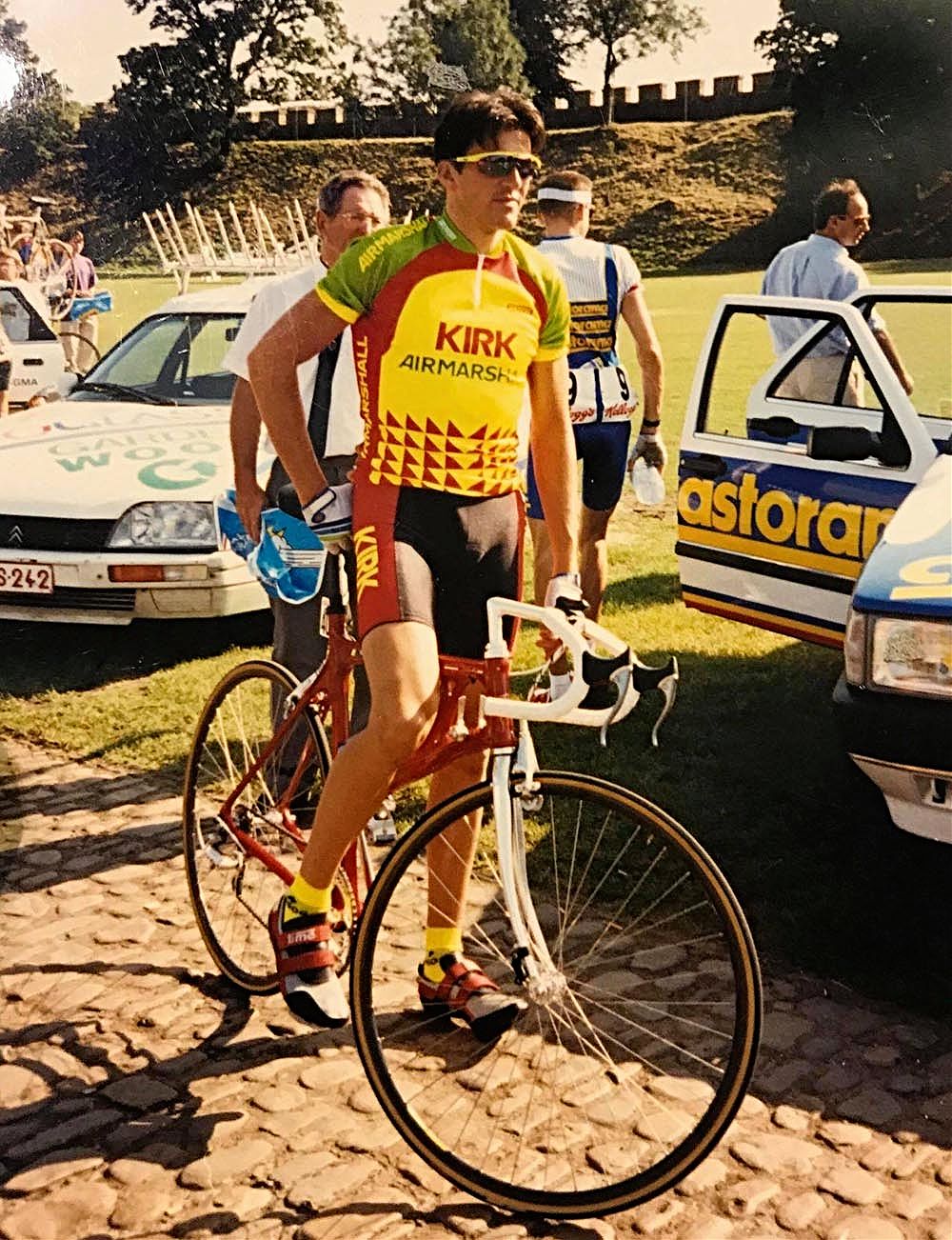
You had some nice results in Belgium in the early 80’s, Steve?
“I’d go over after the Lincoln Grand Prix and stay for three months.
“In one of my first races over there, which was at Overijse, I was third, after the finish a local family overheard that I was looking for a place to stay, they wanted their son to learn English and were cycling fanatics so they took me in.
“I had a lot of podiums but you know it works in Belgium; you get in the break and the local ‘hero’ or a lad who’s trying to get a pro contract, needs a result so…
“I made a good little living over there.
“Perhaps my best result was third in the Omloop van de Vlaamse Scheldeboorden, Jan Bogaert won, Adrie Van Der Poel was fourth with Johan Museeuw seventh.
“It’s not until I look back that I realise the quality of the guys I was riding against.
“I was riding for an amateur team which was sponsored by Tonissteiner mineral water, my last year over there they said they’d be sponsoring a full pro team the next season and offered me a ride on it.
“I turned it down but underestimated the level they were coming in at thinking it might be a ‘Mickey Mouse’ affair but in fact they rode the Tour de France.
“The thing is though if you turned pro in Belgium in those days you were under pressure to engage in stuff that I just didn’t want to do.”
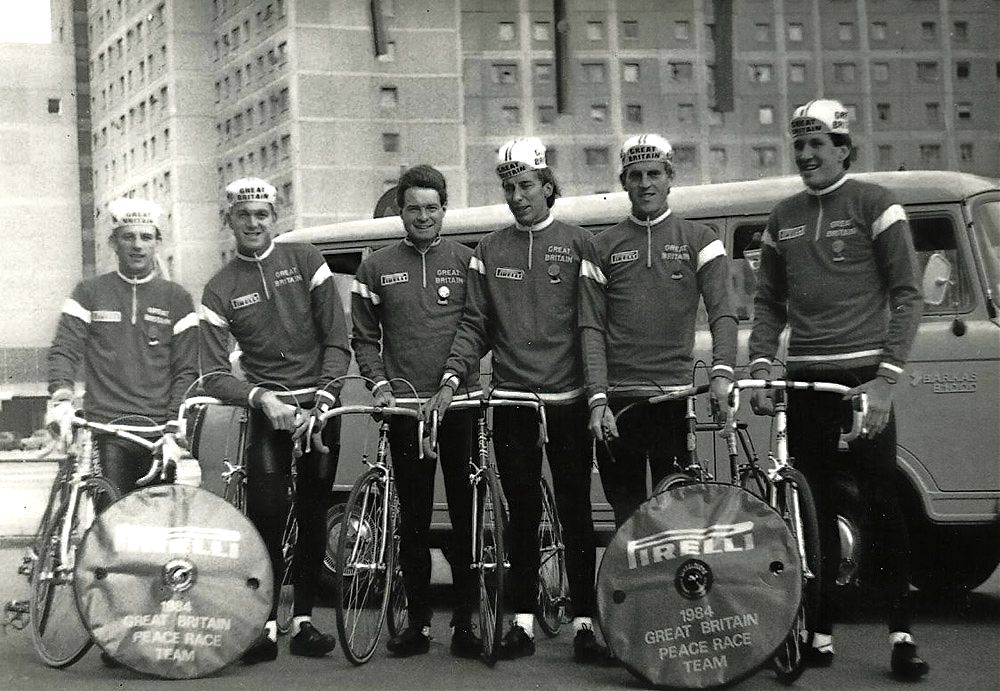
But you didn’t just ride in Belgium, you rode the legendary Peace Race.
“Yes, the 1984 Peace Race, a very hard and fast race with the best amateurs in the world, poor weather, freezing rain in the mountains, massive crashes…
“You’d go in to a town absolutely flat out and there would be cobblestones with loads of tramlines going in every direction, the two stroke engines in the cars back then covered the road surfaces in lots of oil, it was like ice, total carnage at 70kph, I used to just try land on the bodies, not bikes or the ground!
“I had three top 20 finishes and came 50th on GC… a big Spaniard called Miguel Induráin came 74th.
“The Russian, Sergei Sukhoruchenkov won; he was the reigning Olympic champion at the time and one of the best amateur riders the world has ever seen.”
You turned professional with Ever Ready in 1985.
“I’d been riding well and had some wins including a win in the criterium series in De Haan, Belgium where I was second overall.
“It was just past half way through the season and I got a call from Mick Bennett asking if I’d like to join the team for the rest of the season; one of their riders had left the team for some reason.
“It was a good team with guys like John Herety, Steve Fleetwood and Graham Jones
“The first race I rode with them was the Whitby Regatta Pro-Am Road Race in August; John Herety won, his first victory in three years and it was the team’s first win in quite a while, I was fifth so that was a good start to my pro career.
“Late season we rode the GP Denain and GP Isbergues as preparation for the Nissan Tour of Ireland, Kelly was riding and the crowds there were unbelievable.”
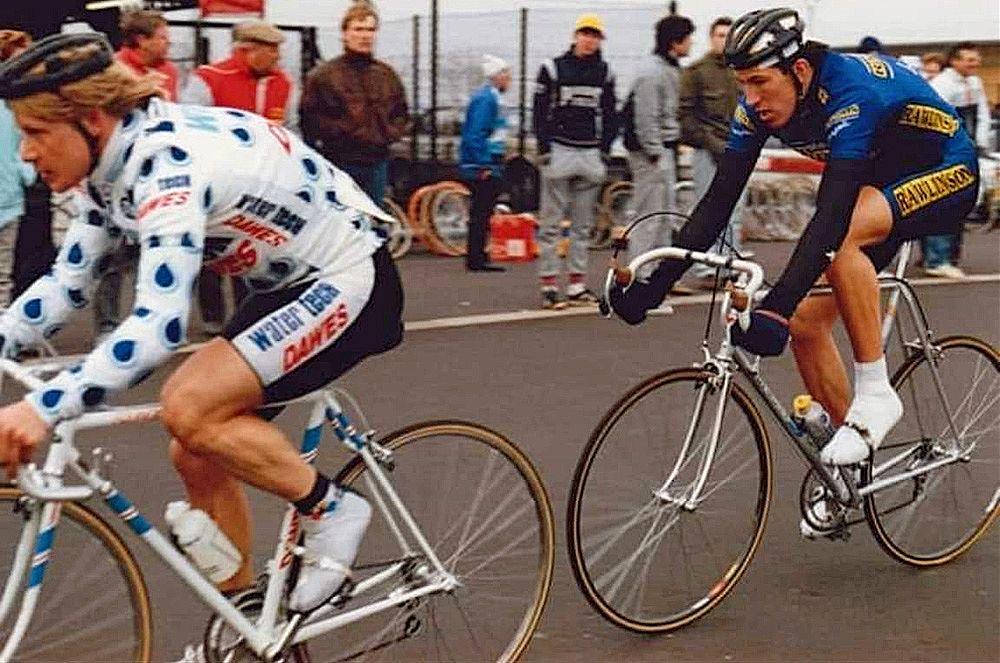
No renewal for ’86 so you rode for Rawlinson, and in ’87 too.
“Yes, Ever Ready folded and I was single-sponsored by John Rawlinson. He was a cyclist who owned a big printing company in London.
“Tony Mills supplied my bike and clothing and Alfa Romeo gave me a car; it was a good set up and the money was good but obviously I had no team and there were a lot of good sprinters around in that era so my game plan was to ride aggressively and get my sponsor’s name on the television.
“In the Kellogg’s race I’d go on the attack and get the Rawlinson name out there; John would invite clients to the races and be delighted when I had his name to the fore.”
The Percy Bilton team for ’88 and ’89.
“That was a good team, run by a chap called Ron Groom who took the reins of the company when Percy Bilton died in 1983.
“The company was a big player; it built much of the M25 London Orbital motorway and was involved in the building of the Channel Tunnel.
“Ron was a real character, he said to my team mate, John Herety; ‘what’s a professional cyclist’s biggest fear, John ?’ John replied that the team, folding and not getting paid was always a worry.
“Ron said; ‘Right, I’ll pay everyone their salary for the year, up front, on January 1st!’
“And he did, that meant we raced hard to get our bonuses – the team had good performance bonuses in place – and prize money.
“I was able to pay my mortgage from our bonuses and prize money.
“He was a fair guy but I remember getting a dressing down from him; I mentioned to him that I really liked riding a carbon fibre ALAN frame, I’m a big guy and climbing wasn’t my forte but the super-light ALAN gave me a bit of a lift on the climbs.
“Ron said; ‘aren’t our bikes good enough for you?!’
“But then he went out and bought carbon fibre frames for us for the Milk Race.”
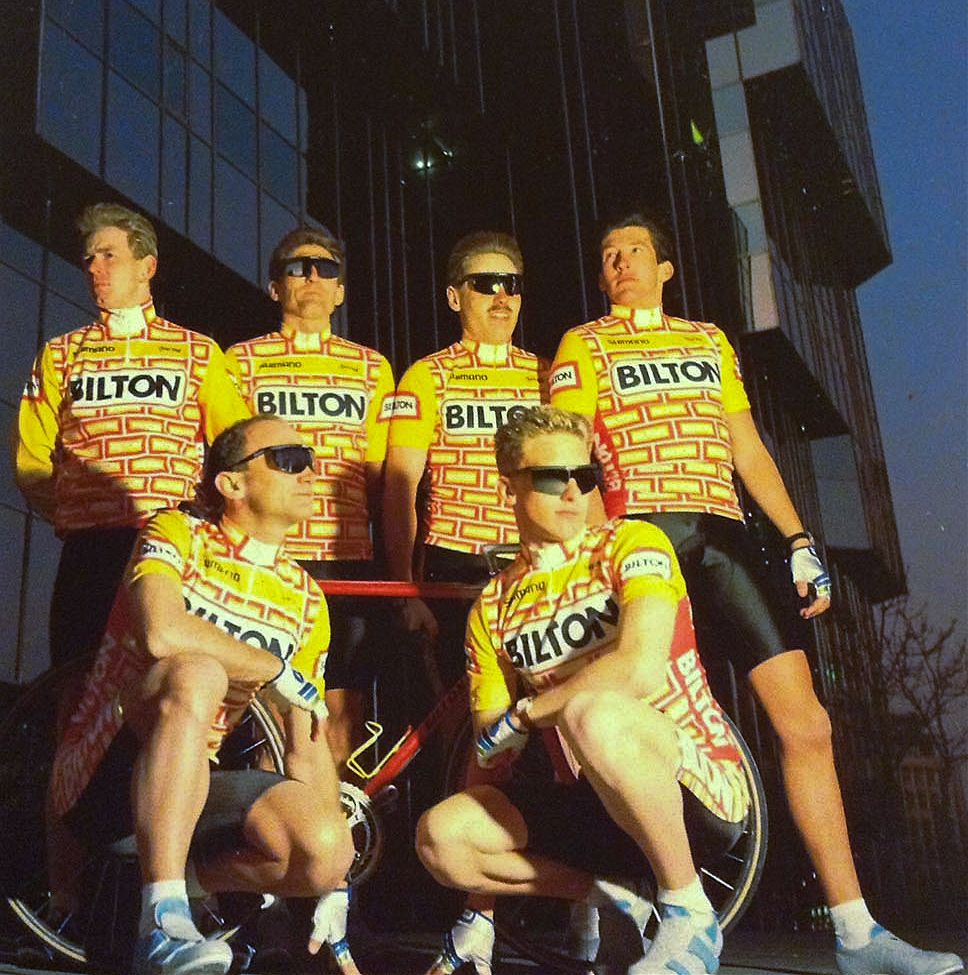
A nice Milk Race stage win for you with Bilton.
“That was ’88, Stage 12, my role was to lead out our sprinter Mark Walsham for the hot spot sprints and stage finishes.
“Mark had won stage 11 Coventry Circuit race after we’d given him a perfect lead out so our morale was sky high.
“It was the last stage from Warwick Castle to Birmingham, 106 miles, there were nine laps of a finishing circuit and I was policing the breaks, there were two away and I got up to them then realised bunch was closing and attacked with 500 metres to go.
“And Mark won the overall points and sprints classification so it was a good race for us.”
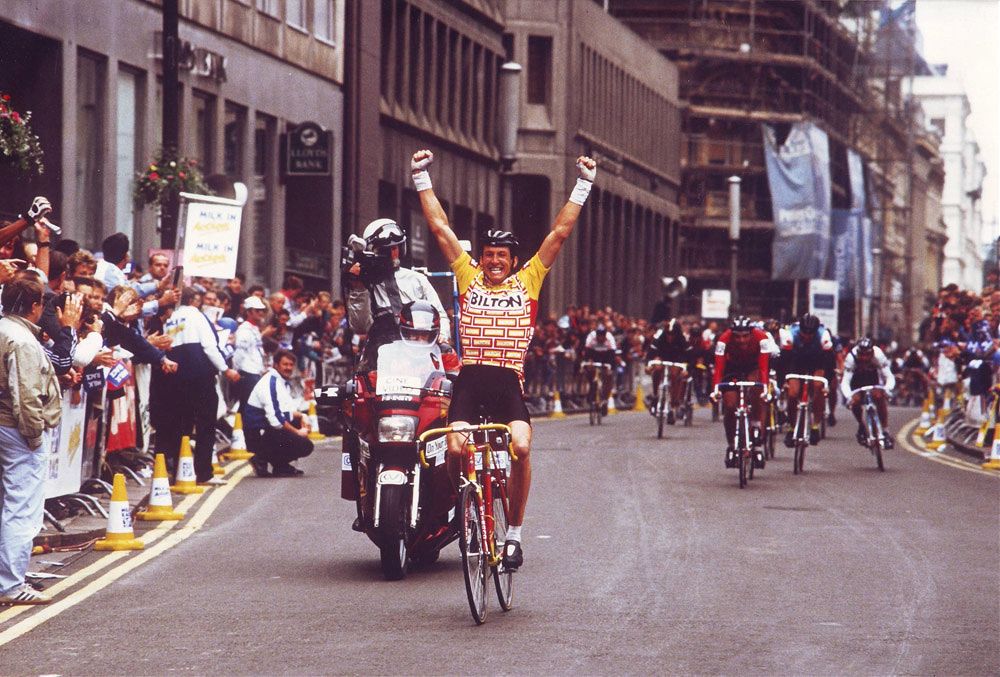
You rode the Tour de Trump with Bilton, what was that like?
“We were outside the hotel the night before the start and there was a commotion and all these guys in suits and shades appeared – and there he was, ‘The Donald’ himself.
“He chatted to us for an age.
“That race had the second biggest price race in the world, bigger than the Giro, with only the Tour de France having a bigger purse.
“We had a good programme with Bilton; John Herety had spent three years with Mercier on the continent and had a lot of good contacts to get us the rides, races like the Tour du Limousin.”
The Airmarshall team for 1990 and those radical Kirk Precision magnesium frames…
“I didn’t like them, they were heavy and broke, Dave Mann broke three of them.
“The team was made up of good lads, Dave, Hilton McMurdo, Ian Sanders – but Bilton was like a Division One soccer team, Airmarshall was like stepping down to Division Three, there wasn’t a lot of money there.”
Campag groupsets with Delta brakes though?
“The Deltas weren’t the best at stopping you, that’s true but I never worried too much about that, as a pro it was about going fast, not stopping!”
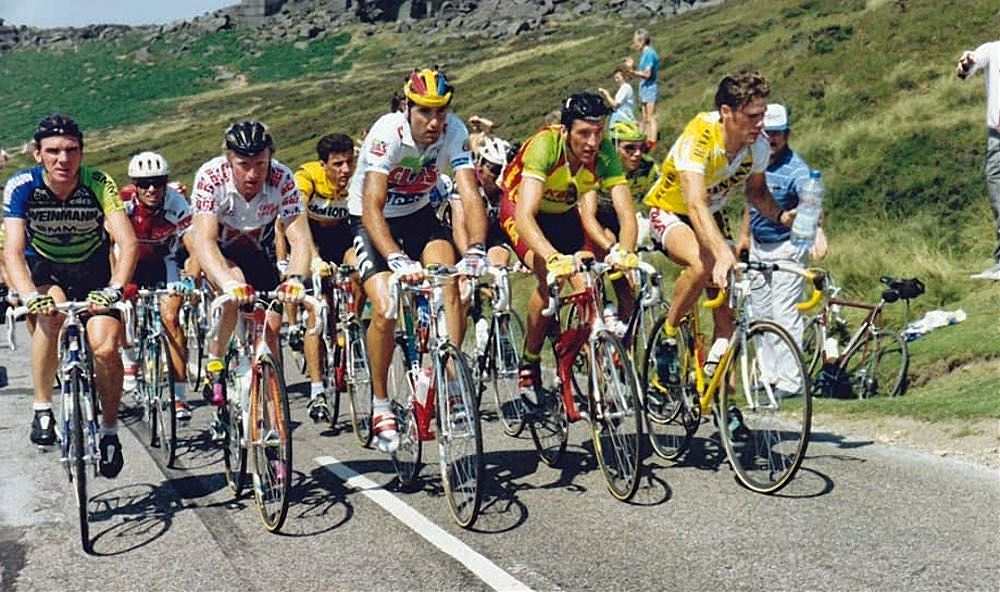
Then Townsend for ’91.
“It was the same again, good lads, Bernie Burns, Neil Hoban, Dave Mann, Hilton McMurdo, Adrian Timmis but not much money.
“With Bilton we’d race on the continent, I’m a big guy and need hard racing to bring me on but with Townsend there wasn’t the money for that.
“I used to pay my way to go with the Raleigh boys to Belgium to race – the Raleigh lads couldn’t understand it, they didn’t want to be there and I was paying to be there!
“But I love Belgium and loved to race there.
“The Belgian pro kermises are 100 miles, full on – when I was preparing for the Spenco 500 mile road race in Texas I’d ride them then do another 40 miles with Nigel Dean.”
Jovigroups – Paros De Ferreira in Portugal for 1992?
“Tim Harris was racing out there, he’d won two stages in the Tour of the Algarve in 1990 and he was signed for that team for 1992, they wanted another British rider and Tim called me to ask if I’d be interested?
“I rode three races for them, then in the GP Costa Azul, which was a six stage race – where Tim won Stage Four – I was coming into good form but had just been distanced from the lead group of 25 riders on a climb and was chasing to get back on the descent with a big Russian guy when this hairpin appeared out of nowhere, I was going too fast.
“I went over the edge, I crushed two vertebrae and broke another two, I had broken ribs too but worst was my ankle.
“The doctor in Portugal said that I wouldn’t race again, that was endorsed by the doctors back in the UK with one guy saying I would have to have my foot amputated.
“But fortunately I found a really good guy – Malcolm Elliot’s next door neighbour, he was a lovely man but told me that it was going to be a; ‘long way’ and Iwas on crutches for 15 months.
“So Costa Azur was my last race.”
Not a great way to close your career but that was a good era to be a pro in the UK.
“I feel lucky that I was born when I was, the guys who were a little older didn’t get that opportunity and now it’s ‘watered down’ because there are so many TV channels, back then there were only four.
“It was a sponsor’s delight.”
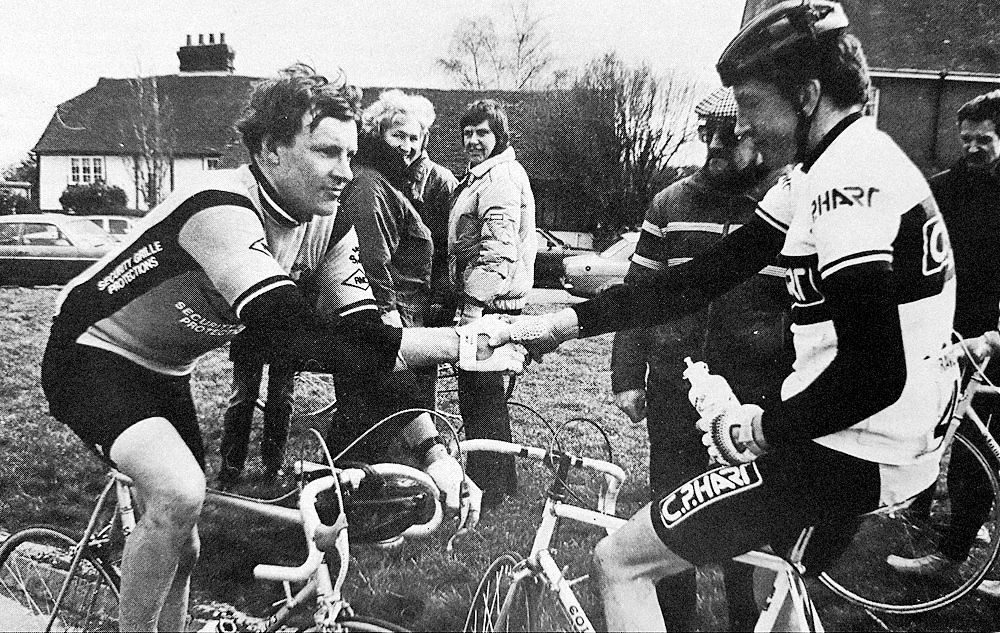
Your career highlight?
“The Milk Race stage win was nice, I had some good results in Belgium – and beating Tony Doyle, who was twice World Professional Pursuit Champion, in a 4.6 kilometre time trial – that was in a stage of the Bill Cox Memorial two day in 1983.”
I was going to ask about the low point but I think we’ve covered that…
“I’ve had my share of crashes but that one in Portugal was something else!”
And if you could do it all over again?
“I think I would turn pro with Tonissteiner, you were under pressure to ‘prepare’ with those Belgian teams but it would have been an interesting experience.
“When I raced in Belgium I beat a lot of guys who went on to have stellar pro careers, so who knows?”

With thanks to Steve for a great wander down Memory Lane, we both miss the 80’s – but not the Kirk Precisions.



